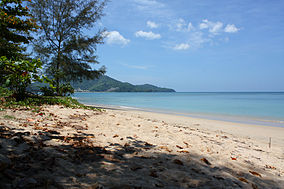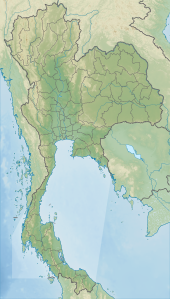Sirinat National Park
| Sirinat National Park | |
|---|---|
| อุทยานแห่งชาติสิรินาถ | |
 Hat Nai Yang | |
| Location | Phuket Province, Thailand |
| Nearest city | Phuket |
| Coordinates | 8°5′17″N 98°17′46″E / 8.08806°N 98.29611°E |
| Area | 90 km2 (35 sq mi) |
| Established | July 1981 |
| Visitors | 51,200 (in 2019) |
| Governing body | Department of National Parks, Wildlife and Plant Conservation |
Sirinat National Park (Thai: อุทยานแห่งชาติสิรินาถ) is a national park in Phuket Province, Thailand. This park, with sections on land and sea, is in the northwest of the island of Phuket.
Geography
Sirinat National Park is in Thalang District, about 30 kilometres (19 mi) north of Phuket town on the coastal section surrounding Phuket International Airport.
The park's total area is 56,250 rai ~ 90 square kilometres (35 sq mi),[1] with 68 square kilometres (26 sq mi) of marine area and 22 square kilometres (8.5 sq mi) land-based.[2] The park includes four main beaches: Hat Nai Thon, Hat Nai Yang, Hat Mai Khao, and Hat Sai Kaeo. Hat Mai Khao is Phuket's longest beach.[2][3]
History
The park was originally known as Nai Yang National Park and became Thailand's 32nd national park on 13 July 1981. It was renamed Sirinat National Park in 1992.[2]
A 2014 Bangkok Post editorial said that, "The latest questionable development in the sad saga of Sirinat National Park in Phuket province raises serious and vexing issues. Among the most pertinent is the old paradox of "Who will watch the watchers?" The Royal Thai Navy has moved into the precious park on the pretext of providing security. But the threats to this little jewel of national land are not physical, and heavily armed military men provide no solution at all".[4]
In January 2016, it was reported that about 1,200 rai of Sirinat Park land was "detached" from the park by unscrupulous officials and sold to property developers, completed with illegal deeds, for 40 million baht per rai or approximately 50 billion baht in total. "The land had been detached from the national park so investers [sic] could build resorts and several well-known hotels,...", according to Mr Damrong Phidet, a former director-general of the National Parks, Wildlife and Plants Conservation Department.[5]
Attractions
Sirinat National Park is best known for its well-preserved white sand beaches. Also, Hat Mai Khao and Hat Nai Yang are both sea turtle nesting areas. Between November and February sea turtles come to lay eggs on these beaches.[2]
Flora and fauna
The park's beach forests, approximately 2 square kilometres (0.77 sq mi) in area, consist of numerous tree species with the effect of providing a windbreak during tropical storms and stabilising the beach sands. Tree species include common ironwood, tulip tree, tropical almond, white barringtonia, cajeput tree, Alexandrian laurel, screwpine, ashoka tree, black plum, elephant apple and morning glory.[2]
Beach forest birds include magpie-robin, common myna, spotted dove, Asian fairy-bluebird, oriole, greater racket-tailed drongo and some bulbul species.[2]
Sirinat National Park also hosts a small area (1 square kilometre) of mangrove forest, located where freshwater and seawater mix in estuarine areas. Tree species here include red mangrove, white mangrove, black mangrove, cannonball mangrove, looking-glass mangrove and Ceriops. Other plant species include Rhizophora apiculata and Derris trifoliata.[2]
Mangrove forest birds include collared kingfisher, Terek sandpiper, bar-tailed godwit, white-breasted waterhen, slaty-breasted rail, white-bellied sea eagle, brahminy kite and large-billed crow.[2]
The mangrove forest hosts some reptiles such as monitor lizard, mangrove snake and turtle.
Mangrove marine life includes shrimp, mudskipper, mullet, grouper and garfish.
Coral reefs are located in the marine section of the park at a distance of 700 metres (2,300 ft) to 1,000 metres (3,300 ft) offshore. Reef species include plate coral, soft coral, sea fan and sea anemone.[2]
Formerly, leatherback sea turtles laid eggs on a stretch of beach in Sirinat National Park. At the park, 166 eggs were laid between 1999–2013, but the survival rate was small given the intensive property development along the beach. Since 2013 no further eggs have been observed there. Thailand was once a sanctuary for leatherback turtles.[6]
See also
References
- ^ "ข้อมูลพื้นที่อุทยานแห่งชาติ ที่ประกาศในราชกิจจานุบกษา 133 แห่ง" [National Park Area Information published in the 133 Government Gazettes]. Department of National Parks, Wildlife and Plant Conservation (in Thai). December 2020. Retrieved 1 November 2022, no 32
{{cite web}}: CS1 maint: postscript (link) - ^ a b c d e f g h i "Sirinat National Park". Department of National Parks (Thailand). Archived from the original on 8 May 2013. Retrieved 31 May 2013.
- ^ "Sirinat National Park". Tourism Authority of Thailand. Retrieved 23 June 2017.
- ^ "The fight to save Sirinat". Bangkok Post. 2014-09-23. Retrieved 27 January 2016.
- ^ "Crooked officials sold Phuket forest reserve land". Bangkok Post. 2016-01-18. Retrieved 27 January 2016.
- ^ Wipatayotin, Apinya (4 December 2017). "Turtle power on wane as trawlers take toll". Bangkok Post. Retrieved 4 December 2017.

